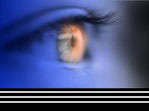Looking at water, you might think that it's the most simple thing around. Pure water is colorless,
odorless, and tasteless. But it's not at all simple and plain and it is vital for all life on Earth. Where there is water
there is life
Water's Chemical Properties
 You probably know water's chemical description is H2O. As the diagram to the left shows, that is one atom
of oxygen bound to two atoms of hydrogen. The hydrogen atoms are "attached" to one side of the oxygen atom, resulting in a
water molecule having a positive charge on the side where the hydrogen atoms are and a negative charge on the other side,
where the oxygen atom is. Since opposite electrical charges attract, water molecules tend to attract each other, making water
kind of "sticky." As the right-side diagram shows, the side with the hydrogen atoms (positive charge) attracts the oxygen
side (negative charge) of a different water molecule.
You probably know water's chemical description is H2O. As the diagram to the left shows, that is one atom
of oxygen bound to two atoms of hydrogen. The hydrogen atoms are "attached" to one side of the oxygen atom, resulting in a
water molecule having a positive charge on the side where the hydrogen atoms are and a negative charge on the other side,
where the oxygen atom is. Since opposite electrical charges attract, water molecules tend to attract each other, making water
kind of "sticky." As the right-side diagram shows, the side with the hydrogen atoms (positive charge) attracts the oxygen
side (negative charge) of a different water molecule.
All these water molecules attracting each other mean they tend to clump together. This is why water drops are, in fact,
drops! If it wasn't for some of Earth's forces, such as gravity, a drop of water would be ball shaped -- a perfect sphere.
Even if it doesn't form a perfect sphere on Earth, we should be happy water is sticky. (http://ga.water.usgs.gov/edu/mwater.html)
Capillary action
 Even if you've never heard of capillary action, it is still important in your life. Capillary action is
important for moving water (and all of the things that are dissolved in it) around. It is defined as the movement of water
within the spaces of a porous material due to the forces of adhesion, cohesion, and surface tension.
Even if you've never heard of capillary action, it is still important in your life. Capillary action is
important for moving water (and all of the things that are dissolved in it) around. It is defined as the movement of water
within the spaces of a porous material due to the forces of adhesion, cohesion, and surface tension.
Capillary action occurs because water is sticky -- water molecules stick to each other and to other
substances, such as glass, cloth, organic tissues, and soil. Dip a paper towel into a glass of water and the water will "climb"
onto the paper towel. In fact, it will keep going up the towel until the pull of gravity is too much for it to overcome.

